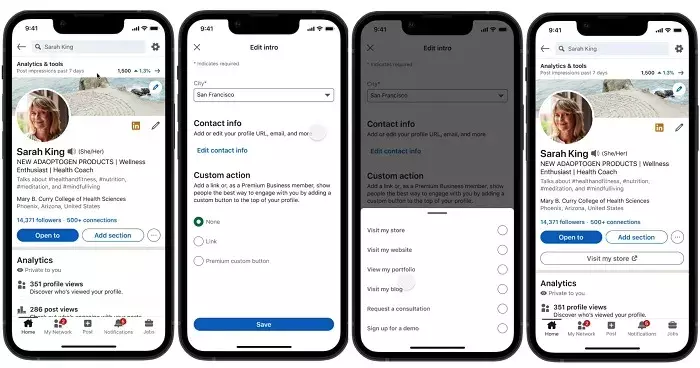LinkedIn, the premier professional networking platform, has consistently sought to enhance user engagement and improve the overall experience for its community. The recent decision to remove the option for Premium subscribers to add custom links to their profiles has sparked various discussions on the platform’s strategic direction. Initially introduced in 2023, this feature allowed users to attach external URLs to their profiles, creating eye-catching call-to-action (CTA) buttons. With phrases like “Visit my Store” or “Learn More About My Services,” these buttons served as crucial tools for individuals looking to drive traffic to their businesses or personal websites.
However, as of now, LinkedIn has opted to eliminate this capability, citing its commitment to refining features that genuinely add value for its user base. This raises intriguing questions about why such a seemingly advantageous feature was deemed expendable. One must ponder whether this was a data-driven decision influenced by user engagement statistics, or a more strategic maneuver aimed at fostering an environment less cluttered with external links that may detract from LinkedIn’s primary function as a professional networking platform.
The Implications for Premium Users
For those Premium subscribers who had engaged with the custom link feature, the implications of this change are significant. Users who previously added a CTA button to their profile will retain it, but the inability to edit or add new links may restrict their ability to adapt to changes in their business or personal endeavors. This lack of flexibility seems antithetical to the dynamic nature of professional growth — a domain where adaptability and evolution are paramount.
While LinkedIn claims that removing this feature will enable them to focus resources on enhancements that offer greater value, it also suggests an inherent irony: the platform is maintaining functionality for corporate entities via Premium Company Pages, which still enjoy the benefits of custom CTA buttons. Data indicates that these business profiles are experiencing considerable engagement, boasting tenfold increases in custom button clicks compared to individual profiles. The double standard here raises eyebrows, particularly as LinkedIn courts individual creators simultaneously, a demographic that could significantly benefit from flexible marketing avenues on their profiles.
An Analysis of User Engagement Trends
Critically, the underlying rationale could be linked to observation patterns in user engagement. The argument that not many visitors utilize these custom links is plausible; however, it risks underestimating the potential of nurturing a vibrant ecosystem for individual users. By pivoting attention solely towards business entities, LinkedIn may be missing opportunities for creators, solopreneurs, and freelancers who have the potential to contribute diverse content that enriches the platform.
In a landscape where digital creation is gaining momentum, relaxing restrictions on individual profiles could actually stimulate greater creativity and content sharing within LinkedIn. As the app strives to become more than just a networking venue, features that promote personal branding and informational sharing should arguably be preserved rather than scrapped. It may even be worth considering how Parler or Substack have influenced conversation patterns; allowing for greater freedom can enhance a platform’s vibrancy and engagement.
Understanding the Bigger Picture
LinkedIn’s removal of the custom link feature may reflect broader industry trends where platforms are increasingly protective of user experience and security. For instance, the rise of spam and potentially harmful links can compromise a platform’s integrity and, consequently, its SEO standing. By limiting the ability to embed external links, LinkedIn could be working to curate a cleaner, more trustworthy space that enhances user confidence.
Interestingly, the decision aligns with the trend of platforms tightening content control, allowing companies to retain a firm grip on the narrative and quality of their environment. However, stifling individual expression can lead to dissatisfaction among users who feel overlooked and constrained by platforms designed predominantly for corporate entities. Aspirations for a rich communal experience may directly clash with operational decisions taken for user safety and platform integrity.
In essence, LinkedIn’s move is not merely a feature withdrawal; it’s indicative of a shifting focus within the platform’s overall vision. Whether this change leads to more engaged users or stifles a burgeoning creator economy remains to be seen, but one cannot ignore the nuanced consequences of such decisions on the diverse LinkedIn community.

